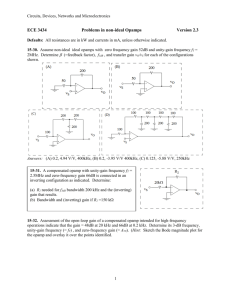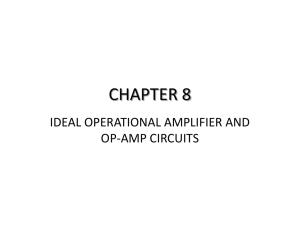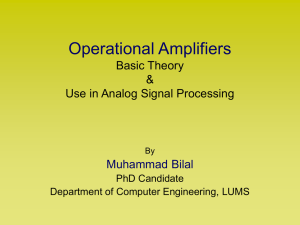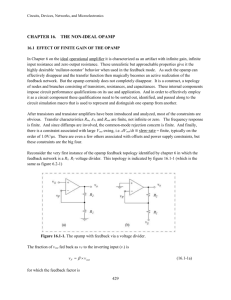v 2 - EngineeringDuniya.com
advertisement
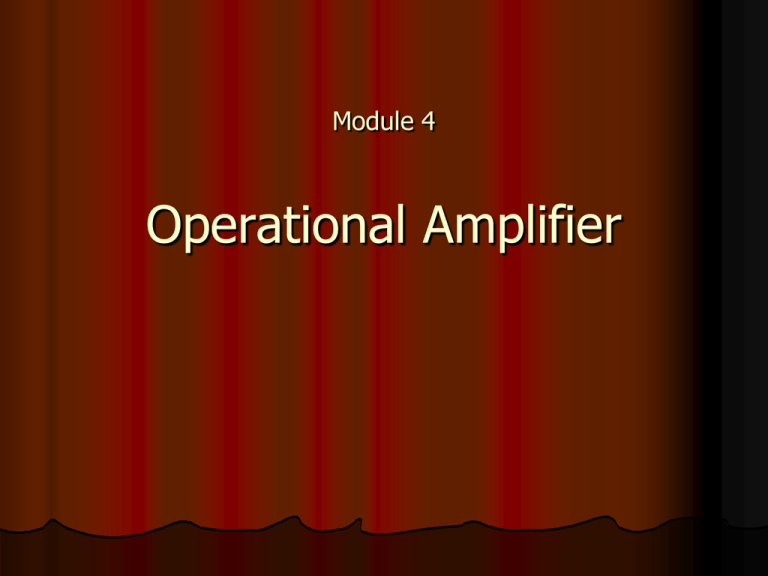
Module 4 Operational Amplifier Contents Introduction OPAMP Symbol Internal block diagram Open-loop configuration Common mode rejection ratio OPAMP equivalent circuit OPAMP characteristics Closed-loop configuration Contents Inverting Amplifier Non-inverting Amplifier Summing Amplifier Difference Amplifier Differentiator Integrator Tutorials Reference book OPAMPS and Linear Integrated Circuits by Ramakanth Gayakwad Introduction Operational Amplifier (OPAMP) is a very high gain amplifier fabricated on Integrated Circuit (IC) Finds application in Audio amplifier Signal generator Signal filters Biomedical Instrumentation And numerous other applications Introduction Advantages of OPAMP over transistor amplifier Less power consumption Costs less More compact More reliable Higher gain can be obtained Easy design OPAMP terminals +VC C Non inverting input + Inverting input – Output –VEE OPAMP terminals OPAMP terminals If input is applied to non inverting input terminal, then output will be in-phase with input If input is applied to inverting input terminal, then output will be 180 degrees out of phase with input If inputs are applied to both terminals, then output will be proportional to difference between the two inputs OPAMP terminals Two DC power supplies (dual) are required Magnitudes of both may be same The other terminal of both power supplies are connected to common ground All input and output voltages are measured with reference to the common ground OPAMP terminals Integrated Circuit Internal Block Diagram Differential Amplifier Stage Intermediate Stage Level Shifter Stage Output Stage Four stages can be identified – Input stage or differential amplifier stage can amplify difference between two input signals; Input resistance is very high; Draws zero current from the input sources Internal Block Diagram Intermediate stage (or stages) use direct coupling; provide very high gain Level shifter stage shifts the dc level of output voltage to zero (can be adjusted manually using two additional terminals) Output stage is a power amplifier stage; has very small output resistance; so output voltage is the same, no matter what is the value of load resistance connected to the output terminal Open-loop configuration If v1 = 0, then vo = –AOLv2 Inverting amplifier If v2 = 0, then vo = AOLv1 Non inverting amp Open-loop configuration AOL is the open-loop voltage gain of OPAMP Its value is very high Typical value is 0.5 million So, even if input is in micro volts, output will be in volts But output voltage cannot cross the value of power supply VCC So, if input is in milli volts, output reaches saturation value Vsat = VCC (or VEE) Open-loop configuration If v1 = v2, then ideally output should be zero But in practical Op-Amp, output is v1 v 2 v o Acm 2 Where, ACM is the common-mode gain of Op-Amp So, final gain equation is: v1 v 2 v o Ad v1 v 2 Acm 2 v o Adv id Acmv icm Open-loop configuration Common-mode rejection ratio It is a measure of the ability of Op-Amp to reject the signals common to both input terminals (noise) Defined as Ad CMRR Acm CMRR dB Ad 20 log10 Acm Problems An OPAMP has differential voltage gain of 100,000 and CMRR of 60 dB. If non inverting input voltage is 150 μV and inverting input voltage is 140 μV, calculate the output voltage of OPAMP Ans: 1.01 V For an OPAMP, when v1 is 0.5 mV and v2 is –0.5 mV, output voltage is 8 V. For the same OPAMP, when v1 = v2 = 1 mV, output voltage is 12 mV. Calculate the CMRR of the OPAMP Ans: 56.48 dB OPAMP equivalent circuit Practical OPAMP Ri AOLvid vi1 vi2 + – Ro vo OPAMP equivalent circuit Ideal OPAMP AOLvid vi1 vi2 + – vo OPAMP Characteristics Ideal OPAMP Infinite differential mode gain Zero common mode gain Infinite CMRR Infinite input resistance Zero output resistance Infinite bandwidth Infinite slew rate Zero input offset voltage Zero input offset current Zero output offset voltage OPAMP Characteristics Differential mode gain Ad Common mode gain Acm It is the factor by which the difference between the two input signals is amplified by the OPAMP It is the factor by which the common mode input voltage is amplified by the OPAMP Common mode rejection ratio CMRR Is the ratio of Ad to Acm expressed in decibels OPAMP Characteristics Input resistance Ri Output resistance Ro It is the equivalent resistance measured between the two input terminals of OPAMP It is equivalent resistance measured between output terminal and ground Bandwidth It is the range of frequency over which the gain of OPAMP is almost constant OPAMP Characteristics Output offset voltage Voo It is the output voltage when both input voltages are zero Denoted as Voo Input offset voltage Vio It is the differential input voltage that must be applied at the input terminals in order to make output voltage equal to zero Vio = |v1 – v2| for vo = 0 OPAMP Characteristics Input offset current Iio It is the difference between the currents in the input terminals when both input voltages are zero Iio = | I1 – I2 | when v1 = v2 = 0 Input bias current Iib It is the average of the currents in the input terminals when both input voltages are zero Iib = (I1 + I2) / 2 when v1 = v2 = 0 OPAMP Characteristics Slew rate SR It is the maximum rate of change of output voltage with respect to time Slew rate has to be very high if OPAMP has to operate efficiently at high frequencies Supply voltage rejection ratio SVRR It is the maximum rate at which input offset voltage of OPAMP changes with change in supply voltage OPAMP Characteristics Practical characteristics of 741C OPAMP Differential mode gain is 200,000 CMRR is 90 dB Input resistance is 2 MΩ Output resistance is 75 Ω Unity-gain Bandwidth is 1 MHz Slew rate is 0.5 V / μs Output offset voltage is 1 mV Input offset current is 20 nA Input bias current is 80 nA Closed-loop configurations Open-loop voltage gain of OPAMP is very high; such high gain is not required in most applications In order to reduce gain, a part of output signal is fed back to the inverting input terminal (called negative feedback) Many other OPAMP characteristics are improvised with this Inverting Amplifier RF Inverting Amplifier Input is applied to inverting terminal Non inverting is grounded Feedback is given to inverting terminal through resistor RF Assuming vo is less than VCC since Ad is very high, vid should be very small; vid taken as almost zero Current entering OPAMP input terminal is almost zero Inverting Amplifier i2 i1 RF 0 + 0V – Virtual ground Inverting Amplifier 0 vo vo i2 RF RF vin 0 vin i1 R1 R1 i1 i2 vin vo R1 RF RF vo vin R1 vo RF AV vin R1 Non Inverting Amplifier RF Non Inverting Amplifier Input is applied to non inverting terminal Feedback is given to inverting terminal Output voltage will be in-phase with input voltage Here again, the following assumptions are made Since Ad is very high, vid should be very small; vid taken as almost zero Current entering OPAMP input terminal is almost zero Non Inverting Amplifier v1 v2 RF i1 i2 Non Inverting Amplifier vid 0 v1 v2 vin v2 vin i1 R1 R1 vo v2 vo vin i2 RF RF i1 i2 vin vo vin R1 RF RF vo vin 1 R1 Problems For an inverting amplifier using OPAMP, R1=1K, RF=100K, vin=0.1sin(ωt). Find vo. Ans: –10sin(ωt) For a non inverting amplifier, R1=10K, RF=100K. Calculate vo if vi = 25 mV dc. Ans: 275 mV dc An ac signal of rms value 2 mV needs to be amplified to 1.024 V rms, 180 degree phase shifted. Design a suitable amplifier choosing R1=1.2K Ans: Inv amplifier with RF=614.4K Voltage Follower Special case of non inverting amplifier where RF=0 Voltage gain is unity. vo = vin Has very high input resistance and very low output resistance; Used as buffer for impedance matching Summing Amplifier (Adder) iF iA iB Summing Amplifier (Adder) vA iA RA iA iB iF vB iB RB vo iF RF vo v A vB RA RB RF RF RF vo v A vB RB RA Difference Amplifier (Subtractor) Difference Amplifier (Subtractor) The circuit is analyzed using superposition theorem Consider only v1 to be present; v2=0 Now derive expression for output voltage vo1 Next consider only v2 to be present; v1=0 Derive expression for output voltage v02 Actual output voltage vo = vo1+vo2 Difference Amplifier (Subtractor) vx RF vo1 vx 1 R2 v1R3 RF 1 vo1 R1 R3 R2 Difference Amplifier (Subtractor) RF vo 2 v2 R2 v1R3 RF 1 vo vo1 vo 2 R1 R3 R2 v1 v2 RF v2 R2 if R1 R 2 R 3 R F Problems Design an OPAMP circuit such that output is given by vo=–(0.5v1+0.75v2) where v1 and v2 are input voltages. Choose RF=10K Design an OPAMP subtractor to have output given by vo 23 v1 v2 Choose RF=R2=1K Design an OPAMP adder/subtractor to get output voltage vo 1 v1 2 v2 v3 2 3 Integrator Integrator Integrator is a circuit whose output is proportional to (negative) integral of the input signal with respect to time Feedback is given through capacitor to inverting terminal Since same current flows through R and C, vin dvo C R dt t 1 vo vindt RC 0 Integrator Differentiator Differentiator Differentiator is circuit whose output is proportional to (negative) differential of input voltage with respect to time Input is given through capacitor, feedback given through resistor to inv terminal Since current through R and C are same, dvin vo C dt R dvin vo RC dt
